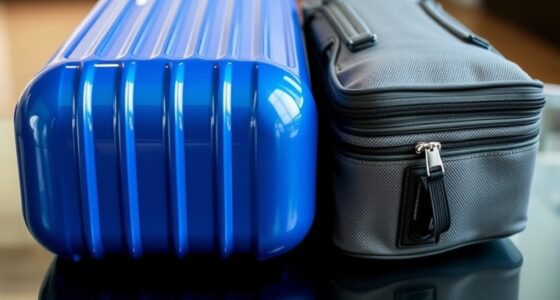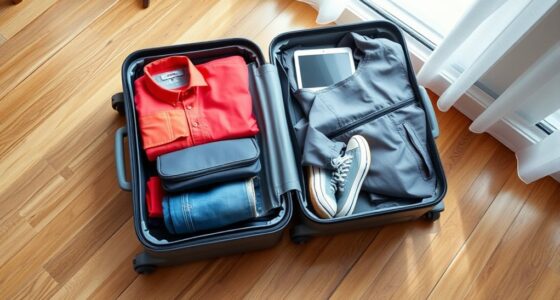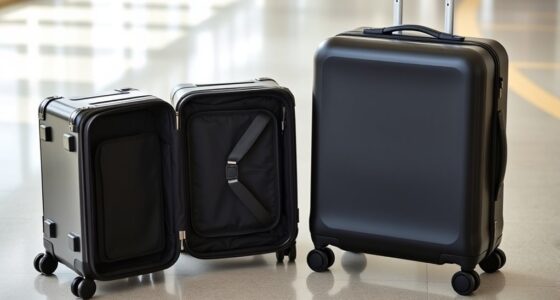When traveling with suits and formal wear, choosing the right garment bag is key to keeping your clothes wrinkle-free and protected. Soft-sided options with breathable fabrics and sturdy options with protective features offer different benefits. Consider size, compartments, and material durability to match your trip needs. Proper packing, organization, and using protective covers help prevent wrinkles and damage. For tips on selecting, packing, and maintaining your garment bag, explore the essential strategies that guarantee your clothing arrives perfect every time.
Key Takeaways
- Choose the right type of garment bag (soft-sided or hard-sided) based on travel needs and protection requirements.
- Select durable, breathable materials like nylon or polyester blends to prevent damage and odors during transit.
- Pack carefully by folding suits with tissue paper, using suit folders, or rolling garments to minimize wrinkles.
- Organize with compartments for accessories, shoes, and essentials to keep items tidy and accessible.
- Maintain your garment bag by inspecting for tears, cleaning exterior surfaces, and storing in a dry, cool place after use.
Types of Garment Bags and Their Benefits

When choosing a garment bag, understanding the different types and their benefits can help you find the perfect fit for your travel needs. Soft-sided bags often feature fabric with excellent breathability, helping to prevent moisture buildup and keep your clothes fresh. Hard-sided options provide durability and superior protection, especially if you’re worried about rough handling. Some garment bags are designed with fabric that offers better breathability, which is ideal for longer trips or delicate fabrics. Additionally, color options matter; darker hues hide stains and wear better, while lighter shades can make it easier to identify your bag quickly. Choosing the right type based on fabric breathability and color options ensures your garments stay in top shape and your luggage is easy to spot. Proper ventilation can also help prevent mold and spoilage, especially when storing items for extended periods. Incorporating features like ventilation systems can further enhance airflow and protect your clothing from moisture damage over time. In addition, selecting a garment bag with quality zippers and closures will help maintain the integrity of your pack during travel. Moreover, understanding the importance of city-specific travel considerations can help you choose the most suitable garment bag for various environments and climates. Using a garment bag with moisture-resistant materials can also provide extra protection against unexpected weather conditions.
Key Features to Consider When Choosing a Garment Bag
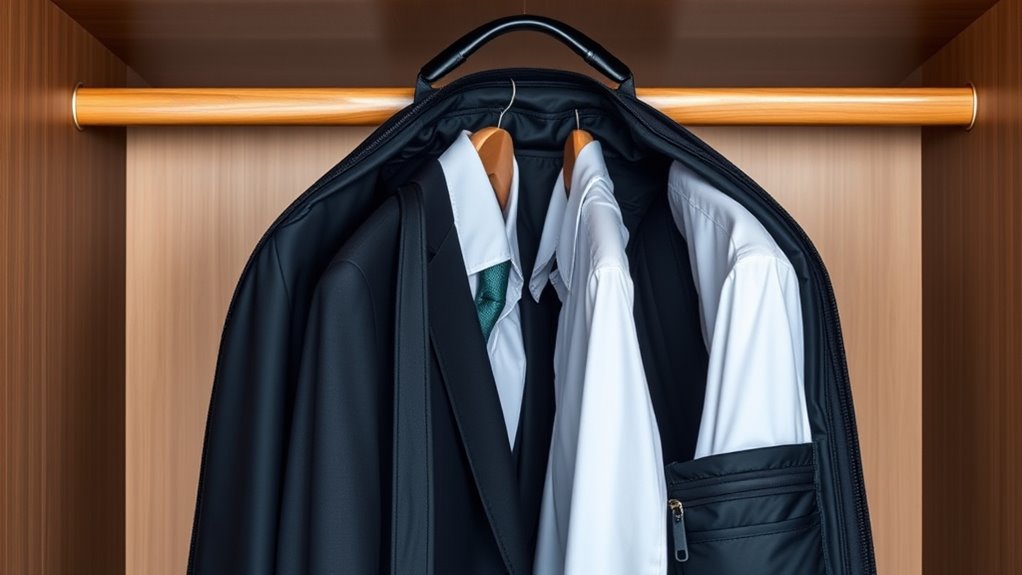
When choosing a garment bag, you should consider the material’s durability and quality to guarantee it lasts through frequent travel. The size and capacity are also important so you can carry everything you need without overstuffing. Paying attention to these features helps you pick a bag that fits your style and travel needs perfectly. Additionally, exploring sound healing science concepts can inspire you to select a calming, stress-reducing design for your travel accessories. Recognizing the importance of safety standards and regulations ensures your garment bag meets necessary standards for secure and reliable travel. Being aware of material safety certifications can further ensure your chosen bag adheres to quality and safety benchmarks. Considering durability testing procedures can also help verify the bag’s resilience over time, especially when selecting a bag made from preppy-inspired materials known for their style and toughness.
Material Durability and Quality
Ever wondered why some garment bags last for years while others fall apart quickly? It often comes down to material durability and quality. Look for fabrics with good tear resistance, so your bag can withstand the rigors of travel without ripping. Fabric breathability is also essential; a breathable material helps prevent mold and odors by allowing air circulation around your clothes. High-quality fabrics like nylon or polyester blends often offer a balance of strength and breathability, making them ideal choices. Cheaper materials may save money upfront but tend to wear out faster, compromising protection for your suits and formal wear. Investing in a garment bag with durable, breathable fabric ensures your clothing stays protected and in pristine condition trip after trip. Additionally, selecting fabrics with material durability can help you better plan for the costs associated with your travel gear, especially if you frequently visit different regions. Being aware of quality standards in manufacturing can also guide you toward more reliable and long-lasting options. To further extend the lifespan of your garment bag, consider proper maintenance and storage practices to keep the fabric in optimal condition. Incorporating advanced fabric technology can also enhance the overall performance and longevity of your garment bag.
Size and Capacity Options
Choosing the right size and capacity for your garment bag is vital to make certain it meets your travel needs. Consider how many suits or dresses you’ll carry and whether you need extra compartments for accessories. Look at the fabric weave; a tightly woven fabric offers better protection against wear and tear, making sure your garments stay pristine. Capacity varies from slim designs for minimal travel to larger options with multiple compartments for extended trips. Color options also matter—select a hue that suits your style or makes your bag easy to spot on a luggage carousel. Make certain the size aligns with your airline’s carry-on restrictions if applicable. Additionally, selecting a vetted brand like Grace for Life Designs can ensure durability and style. Utilizing automation in business intelligence can help you analyze your packing habits and optimize your travel gear choices. Understanding contrast ratio in your luggage or its presentation can also assist in quick identification among other bags. Incorporating hybrid bike concepts such as versatile storage compartments can further enhance your packing efficiency. Ultimately, the right size and capacity ensure convenience without sacrificing protection or style. Incorporating pimple patches into your skincare routine can also help maintain clear skin, especially when traveling and exposed to different environments.
How to Pack Suits and Formal Wear Efficiently

Packing suits and formal wear efficiently requires careful planning to prevent wrinkles and keep your clothing looking sharp. Start by turning your suit jacket inside out, then fold it along the natural creases, using a suit folder or a clean, dry towel to smooth out wrinkles. Use high-quality hangers and place your suits in a garment bag designed for travel, which helps maintain fabric care. Roll your pants and shirts tightly to save space, placing delicate items at the top to avoid crushing. Incorporate travel accessories like lint rollers and wrinkle release sprays for quick touch-ups. Pack essentials such as garment bags with reinforced seams and compartments that keep your clothing secure and organized. Properly tool organization and securing garments in protective covers help prevent damage during transit. Additionally, choosing a garment bag with adequate padding and ventilation can further preserve your suits and formal wear, ensuring they arrive in pristine condition. To further safeguard your clothing, consider using clothing protectors like suit covers or tissue paper to minimize friction and creases during travel. Using specialized packing techniques can also optimize space and reduce the risk of damage during transit. Employing fabric care techniques such as gentle steaming or hanging your garments in a steamy bathroom can help eliminate minor wrinkles upon arrival. This approach ensures your formal wear stays pristine and ready to wear.
Tips for Preventing Wrinkles During Transit

To prevent wrinkles during transit, make sure you properly fold your garments, keeping them smooth and flat. Using a protective covering, like a garment bag or plastic wrap, adds an extra layer of security against creases. These simple steps help your clothes stay crisp and ready to wear once you arrive. Additionally, employing proper folding techniques can further reduce the risk of wrinkles and maintain your garments’ appearance.
Properly Fold Garments
When you fold garments properly, you considerably reduce the chances of wrinkles during transit. Focus on fabric care by handling delicate materials gently and avoiding tight folds that can cause creases. Use effective packing techniques, such as folding along natural seams and smoothing out air pockets, to maintain the garment’s shape. For shirts and suits, fold in thirds or roll tightly to minimize creases. Keep heavier items at the bottom of your bag to prevent crushing lighter fabrics. Avoid overstuffing your luggage, as this can force garments into tight spaces, leading to wrinkles. Proper folding not only preserves the appearance of your clothing but also makes unpacking easier. Additionally, understanding relationship patterns can help you anticipate how your belongings might shift during travel, ensuring your garments stay neat. Mastering these packing techniques ensures your garments arrive crisp and ready to wear.
Use Protective Covering
Have you ever noticed how easily garments can get wrinkled during transit? Using a protective cover can make a big difference in garment preservation. Slip your suits and formal wear into a sturdy, breathable protective cover before placing them in your garment bag. This extra layer helps prevent friction, wrinkles, and dust from settling on your clothes. A protective cover also shields your garments from accidental spills or dirt during travel. Make sure the cover fits well and isn’t too tight, so your clothes aren’t compressed or creased. Proper air circulation within the cover can help reduce moisture buildup that might cause wrinkles or odors. By taking this simple step, you’ll keep your garments looking crisp and fresh, ready to wear upon arrival. Protecting your clothes with a cover is a smart, easy way to maintain their pristine condition during transit. Additionally, choosing the right garment protection can further enhance your clothing’s safety while traveling.
Best Practices for Hanging and Transporting Your Clothing

Hanging your clothing properly and transporting it carefully can make all the difference in maintaining its appearance. To do this effectively, consider the following best practices:
- Use the right hanger types—preferably sturdy wood or padded hangers—since they support fabric breathability and prevent creases.
- Avoid overcrowding your garment bag, giving each item ample space to breathe and reducing wrinkling.
- Keep delicate fabrics away from rougher clothing to prevent snagging and damage during transit.
Choosing hangers that support fabric breathability helps your clothes stay fresh and wrinkle-free. Always hang your garments smoothly, ensuring they’re not bunched or compressed, making your travel experience seamless and your clothing look pristine upon arrival.
Size and Capacity Options for Different Travel Needs

When choosing a garment bag, you’ll want to take into account whether a compact design suits your trips or if you need a spacious option for extended travel. Compatibility with your suitcase is also important to make certain of smooth packing and transport. Assess your travel needs to find the right size and capacity that keeps your clothes protected and organized.
Compact vs. Spacious Designs
Choosing between compact and spacious garment bags depends on your travel needs and packing style. If you prefer minimal packing or short trips, a compact bag is ideal. It’s easier to handle and fits easily into small spaces. For longer trips or multiple suits, a spacious design offers more room and better organization. To maximize space, use effective folding techniques and select appropriate hanger types that keep your clothes wrinkle-free. Here are some tips:
- Use folding techniques that minimize creases and save space.
- Opt for slim, sturdy hangers to prevent unnecessary bulk.
- Consider the bag’s capacity to ensure it accommodates your wardrobe comfortably without overstuffing.
These choices help you stay organized and keep your garments wrinkle-free, no matter the size of your garment bag.
Suitcase Compatibility Options
Selecting the right garment bag depends heavily on your suitcase’s size and capacity to guarantee your clothing stays protected and organized during travel. You’ll want to contemplate your suitcase’s dimensions and choose a garment bag that fits comfortably without overstuffing or causing strain. Many brands offer various color options, making it easier to identify your bag quickly. When comparing brands, look at their size options, capacity, and how well they integrate with different suitcase styles. Some brands specialize in slim, lightweight designs, ideal for carry-ons, while others offer larger options for extended trips. Check brand comparisons for durability, features, and compatibility to ensure you pick a garment bag that seamlessly fits your suitcase, meets your capacity needs, and suits your style preferences.
Materials Used in Garment Bags and Their Advantages

Garment bags are crafted from a variety of materials, each offering unique benefits that suit different needs. Choosing the right fabric can enhance durability, weight, and style. Some options include:
Selecting the right fabric for your garment bag enhances durability, style, and environmental sustainability.
- Polyester and nylon: Known for their affordability and durability, these materials benefit from advanced fabric technology that makes them resistant to wrinkles and water.
- Eco-friendly materials: Made from recycled fabrics or sustainable sources, these bags are perfect if you want to lessen your environmental impact while still offering protection for your garments.
- Leather and faux leather: Offering a sleek, professional look, these materials are sturdy and often feature innovative fabric technology to improve water resistance and longevity.
Knowing your options helps you select a garment bag that balances style, protection, and sustainability.
Additional Compartments and Features for Organized Packing
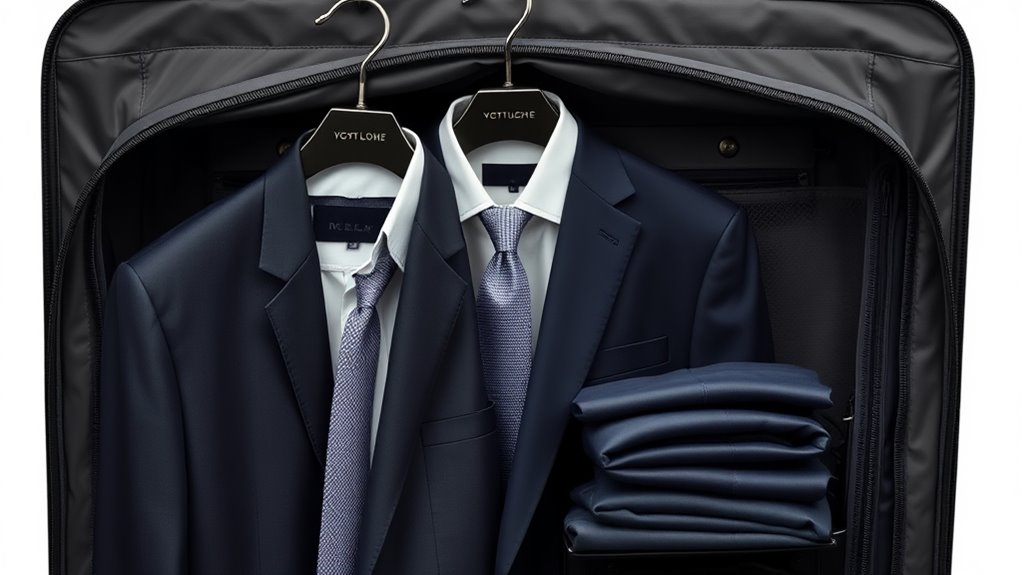
To stay organized during travel, many garment bags now include additional compartments and features designed to keep your belongings tidy and accessible. These compartments enhance compartment organization, allowing you to separate shoes, toiletries, or undergarments from your suits and dresses. Dedicated accessory storage keeps smaller items like ties, jewelry, or belts secure and easy to find. Some garment bags feature zippered pockets or mesh compartments, which help prevent items from shifting or getting lost. External pockets provide quick access to essentials like travel documents or chargers. By choosing a garment bag with these added features, you streamline packing and ensure your items stay neat throughout your trip. This thoughtful organization minimizes wrinkles and makes unpacking faster and more efficient.
Maintenance and Care of Your Garment Bag

Proper maintenance and care are essential to guarantee your garment bag remains in top condition and protects your clothing effectively. Regularly inspect your bag for tears or worn fabric, and clean it to extend its lifespan. To keep it in prime shape, follow these tips:
Regularly inspect and clean your garment bag to keep it in top condition and protected.
- Use a damp cloth to gently wipe down the exterior, focusing on areas prone to dirt and stains.
- For fabric care, spot clean stains with mild soap and water, taking care to avoid damaging the material.
- Store your garment bag in a cool, dry place when not in use to prevent mold or mildew buildup.
Avoid harsh chemicals that could weaken fabric fibers, and always allow the bag to dry completely before storing. Proper care guarantees your garment bag stays durable and effective.
Packing Hacks for Ensuring Your Formal Wear Arrives Perfectly

Ensuring your formal wear arrives in perfect condition requires smart packing hacks that minimize wrinkles and prevent damage. Start by folding your suit carefully, using tissue paper between layers to aid wrinkle prevention. Place your garment inside a sturdy garment bag, hanging it to maintain shape. Rolling your clothes can also help with garment preservation and reduce creases. Use the table below to choose the right packing method:
| Packing Method | Benefits |
|---|---|
| Flat Folding | Minimizes wrinkles |
| Rolling | Saves space, reduces creases |
| Hanging | Prevents wrinkles, maintains shape |
| Tissue Paper | Protects fabric, prevents creases |
With these hacks, your formal wear stays crisp, wrinkle-free, and ready to impress.
Frequently Asked Questions
Are Garment Bags Suitable for Carry-On or Checked Luggage?
Garment bags are generally suitable for carry-on compatibility, making it easy for you to keep your suits and formal wear wrinkle-free during travel. They’re also suitable for checked luggage if you prefer to pack more securely or have larger items. Just make certain your garment bag fits within your airline’s size limits for carry-ons, and use a sturdy, well-padded bag for checked luggage to protect your clothes.
How Do I Choose the Right Size for My Travel Needs?
You should choose a garment bag size based on your travel duration and fabric thickness. For short trips with lightweight fabrics, a compact bag suffices, while longer journeys or thicker fabrics require a larger bag to prevent wrinkles and damage. Measure your suits and consider how much space you need for accessories. Opt for a size that comfortably fits your clothing, ensuring easy carry-on or checked luggage compatibility.
Can Garment Bags Be Used for Delicate or Specialty Fabrics?
Think of your delicate fabrics as treasures that deserve extra care. Yes, garment bags can be used for delicate or specialty fabrics, offering essential fabric protection and delicate handling during travel. Look for bags with soft, breathable linings and sturdy construction to prevent snags and wrinkles. This way, you keep your fine garments safe and pristine, ensuring they arrive looking perfect every time.
What Security Features Should I Look for in a Garment Bag?
When choosing a garment bag, look for security features like lockable zippers or combination locks to keep your clothing safe. Additionally, select a bag that offers fabric protection with sturdy, padded walls and a durable exterior. These features guarantee your suits and formal wear stay secure and wrinkle-free during travel. Prioritizing security features and fabric protection helps you confidently transport delicate or valuable garments without worry.
How Long Can I Expect a Garment Bag to Last With Proper Care?
Did you know that a well-maintained garment bag can last over five years? With proper care, its durability factors like material quality and regular cleaning can substantially extend its lifespan. To keep it in top shape, follow maintenance tips such as avoiding overstuffing, storing in a cool, dry place, and inspecting zippers and seams periodically. This way, your garment bag stays reliable for many trips ahead.
Conclusion
Choosing the right garment bag guarantees your suits and formal wear arrive pristine, ready for any occasion. When you pack thoughtfully, you’re not just safeguarding your clothes—you’re preparing for moments that matter. Sometimes, the best trip is about more than the destination; it’s about the confidence you carry in your perfectly packed wardrobe. Remember, a well-organized bag isn’t just travel gear—it’s a reflection of your attention to detail and style.


